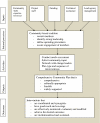Conceptual framework of the Controlling Asthma in American Cities Project
- PMID: 21337048
- PMCID: PMC3042064
- DOI: 10.1007/s11524-010-9473-1
Conceptual framework of the Controlling Asthma in American Cities Project
Abstract
The Controlling Asthma in American Cities Project (CAACP) was designed to improve the control of asthma in inner-city populations of children with a disparate burden of symptoms and adverse outcomes. As with many chronic diseases, asthma is the manifestation of multiple biologic, environmental, and social determinants. In addition to appropriate medical management, individuals with asthma must have logistical, financial, and cultural access to environments that allow avoidance of asthma triggers and encourage good asthma management practices. In recognition of this complexity, the CAACP required the seven project sites to coordinate and synchronize multiple interventions (education, healthcare access, medical management, trigger reduction) at multiple levels (individual, home, school, community, and policy) through the collaboration of relevant groups, institutions, and individuals. This paper describes the "program theory" of the CAACP project-the assumptions about how the project worked, how the components were linked, and what outcomes were anticipated. It relates the subsequent papers in the supplement to the program theory and describes how the papers can inform and guide other community-based interventions, and advance the translation of scientific knowledge to effective interventions in communities of need.
Figures



Similar articles
-
Family and home asthma services across the Controlling Asthma in American Cities Project.J Urban Health. 2011 Feb;88 Suppl 1(Suppl 1):100-12. doi: 10.1007/s11524-010-9472-2. J Urban Health. 2011. PMID: 21337056 Free PMC article.
-
Considerations and challenges for planning a public health approach to asthma.J Urban Health. 2011 Feb;88 Suppl 1(Suppl 1):16-29. doi: 10.1007/s11524-010-9515-8. J Urban Health. 2011. PMID: 21286828 Free PMC article.
-
Assessing community-based approaches to asthma control: the Controlling Asthma in American Cities Project.J Urban Health. 2011 Feb;88 Suppl 1(Suppl 1):1-6. doi: 10.1007/s11524-010-9480-2. J Urban Health. 2011. PMID: 21337047 Free PMC article. No abstract available.
-
Asthma in inner cities.J Natl Med Assoc. 1999 Aug;91(8 Suppl):1S-8S. J Natl Med Assoc. 1999. PMID: 12653387 Free PMC article. Review.
-
A review of barriers to effective asthma management in Puerto Ricans: cultural, healthcare system and pharmacogenomic issues.J Asthma. 2014 Feb;51(1):97-105. doi: 10.3109/02770903.2013.845205. Epub 2013 Oct 17. J Asthma. 2014. PMID: 24040906 Review.
Cited by
-
A model-driven approach to qualitatively assessing the added value of community coalitions.J Urban Health. 2011 Feb;88 Suppl 1(Suppl 1):130-43. doi: 10.1007/s11524-010-9520-y. J Urban Health. 2011. PMID: 21337059 Free PMC article.
-
Family and home asthma services across the Controlling Asthma in American Cities Project.J Urban Health. 2011 Feb;88 Suppl 1(Suppl 1):100-12. doi: 10.1007/s11524-010-9472-2. J Urban Health. 2011. PMID: 21337056 Free PMC article.
-
Maternal intimate partner violence exposure, child cortisol reactivity and child asthma.Child Abuse Negl. 2015 Oct;48:50-7. doi: 10.1016/j.chiabu.2014.11.003. Epub 2014 Nov 27. Child Abuse Negl. 2015. PMID: 25435104 Free PMC article.
-
Considerations and challenges for planning a public health approach to asthma.J Urban Health. 2011 Feb;88 Suppl 1(Suppl 1):16-29. doi: 10.1007/s11524-010-9515-8. J Urban Health. 2011. PMID: 21286828 Free PMC article.
-
CDC's National Asthma Control Program: Looking Back with an Eye Toward the Future.Prev Chronic Dis. 2024 Sep 19;21:E72. doi: 10.5888/pcd21.240051. Prev Chronic Dis. 2024. PMID: 39298795 Free PMC article. No abstract available.
References
-
- Moorman JE, Rudd RA, Johnson CA, et al. National surveillance for asthma—United States, 1980–2004. MMWR Surveill Summ. 2007;56(8):1–54. - PubMed
-
- 2007 NHLBI Morbidity and Mortality Chart Book. National Institutes of Health; National Heart, Lung, and Blood Institute; 7 A.D. Jun 1.
-
- Phipatanakul W. Environmental factors and childhood asthma. Pediatr Ann. 2006;35(9):646–656. - PubMed
Publication types
MeSH terms
LinkOut - more resources
Full Text Sources
Medical
Research Materials

